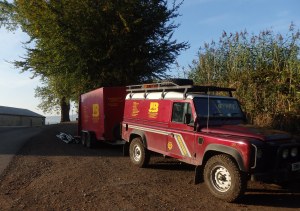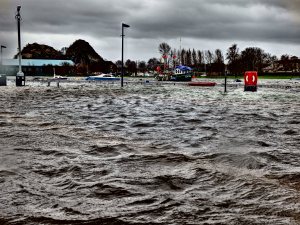Sometimes, when there is an absence of evidence in a situation, people fall into the bad habit of wishful thinking, filling the blanks with apparent ‘no-brainer’ assumptions that are hoped for rather than deductively constructed. Hands-up – I’m certainly guilty of it from time to time.
Argumentum ad ignorantiam, or an ‘argument from ignorance’ is used to describe an argument that is made illogically, on the basis that if something has not been proven to be true, it is therefore false – or vice versa (the Latin is fair flowing today…) It is normally seen when empirical evidence just isn’t available, for example in consideration of whether there is a God.
But what about when evidence IS available, but it is being withheld or manipulated to skew the debate towards one particular outcome? What’s the fancy name for that? Well, I call it ‘living under a vulnerable and poorly led Council administration’. Sorry it’s not in Latin.
There have been several communiqués from West Dunbartonshire Council about the proposal to redevelop the sports facilities on Posties Park, and they have been singularly positive in tone. This is perhaps unsurprising, as investment in community facilities is typically good news. However, in this case, the Council are only providing half of the story, and the bit they are omitting is critical to fully understanding the change ahead.
Let’s have a look at the official statement that was issued on the Council Facebook page after the IRED Committee gave this project the green-light :
I’ve highlighted a few sections.
Whilst the overall gist of this statement is accurate, there are some key parts which are erroneous.
First of all, it states that the new facilities will be “for the whole community”, but, sadly this is just not true. The current facility is indeed universally accessible, but, although this proposal purports to be a “direct replacement”, the new facility is to be limited mainly to schools use, and pay-to-use in all other cases. None of the bulletins that the Council put out, either before or after the IRED Committee, explicitly stated that the new facilities would be pay-to-use, and they only admitted this after being directly challenged by members of the public. However you dress up the language, the fact remains that, levying a charge for a previously free facility, is a net loss to the whole community, and will, in fact, exclude some of the most marginalised and disadvantaged members of our society.
Perhaps the Council might argue that they were just exercising a flowery use of language and that my point is getting into semantics. So let’s then consider paragraph four of the statement above :
“The development will be created directly on top of the current track so will have no impact on the open space area of Posties Park…”
This statement isn’t just disingenuous – it is completely false.
Firstly, let us be completely clear about one thing : the current proposal would see the removal of access rights to a part of our park which is currently fully accessible. It is therefore completely untrue to say that there will be no impact on the open space. Part of Posties Park – all of which is currently designated as open green space on our local plan – would be fenced off and would no longer be accessible except by payment of a fee/Council permission.
Next, let’s consider the claim that “the development will be created directly on top of the current track”. This is another one of those half-truths, it would seem. The proposal is indeed for a new running track to be laid on top of the old one, but what about the rest of the proposed development – the new changing pavilion building and the car-park? Where are those going to go? They certainly won’t be on the land where Marinecraft currently sits, as, under this proposal, it is to be sold off to become part of the Sandpoint Marina estate. Therefore, the only other option would see the building and the car-park being sited on what is currently green space. I wrote earlier about how every part of Posties Park has been re-surveyed this week, at a cost of £20,000 from Council coffers. Enquiries made to the Council confirm that these surveys were indeed in respect of the forthcoming funding application to sportscotland and that “a large proportion of the works are focussing around both existing and proposed properties on the site”. And yet, nowhere in any of the Council bulletins on social media or local press, nor indeed within the papers provided to the IRED Committee, do we see any detail on these “proposed properties”, which will, almost certainly, further restrict the available green space at Posties.
In actual fact, we don’t even know for sure whether the new building will be a small changing pavilion, like the one at Dumbarton Common, or whether it will be a new gym to replace Marinecraft. Both options are apparently on the table, yet currently undecided and dependant on external factors. We don’t know if the proposed car park will be for six cars or sixty, although it will almost certainly need to be large enough to accommodate the coaches which will be bussing “thousands of school children in on a daily basis” from the local schools. Do the Council have these details? Of course they do, or they wouldn’t be investing thousands of pounds of Council money on professional services and staff time. Yet, have any of these important details made their way into the public forum? No, they have not. Instead, we get statements like the one shown above, where material omissions mislead and confuse.
So I thought I’d do a bit of that ‘filling in the blanks’ process that I referred to in my opening paragraphs. Based on the sites that JB Engineering were asked to survey, and working on the assumption that the Council won’t want to diminish their current lettings portfolio of three pitches on Posties, I have posited that there are a few potential target areas for the new building(s)…
I’ve highlighted in red the current Marinecraft site that is to be sold off to give an idea of the footprint of a new building, should the decision be to build a new gym. Obviously, this doesn’t include any car-parking which would probably at least double the square footage, and, of course, there may need to be an access road constructed, so keep all of that in mind. The most likely sites, in terms of size, would seem to be on the lower field, where the road begins to bend round (marked X in blue), and on the upper field to the side of the current football pitch (again, marked X in blue). I’ve also highlighted (with X in white) the other smaller green spaces where a small pavilion might be feasibly built – although it should be noted that there are trees either directly on these sites or encircling them, so this may limit construction. Bear in mind that the lower field is a functional flood plain, and that SEPA had concerns about construction on this site – as did Ramboll who cited potential ‘cost implications and programme delays’ in trying to build here. Remember also that the perimeter of the entire Posties site is to be part of the proposed future Riverside development, and have a pedestrian walkway all around it.
There are, clearly, potential sites on Posties which might conceivably hold a new gym or a changing pavilion, but all of these will diminish the available park-land (except, of course, if the Council holds onto Marinecraft, and re-uses that site – which is currently NOT being proposed.) The concerning part is that our Council is not transparently sharing their plans and inviting open public discussion, despite knowing how fiercely the people value this space. £20,000 of public money has already been spent this week on a barrage of surveys of Posties Park, but the public have not been consulted at all, nor indeed even given the full facts upon which to make a decision.
It’s time for our Council to treat the community with respect and stop insulting our intelligence. Remember – the Councillors work for us. If they really believe that the current proposal is, on balance, the best possible option, then they should share ALL of the facts about this development and stop hiding behind half-true sound-bites. They should be prepared to stand up and defend their decision, and to have a fair and democratic consultation with all of the interested parties, and genuinely try to find a solution that works for everyone.
It’s time for this ‘spin’ class to end.
-MAx























